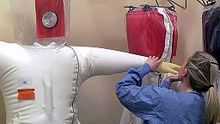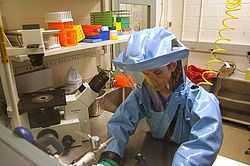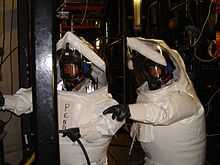Positive pressure personnel suit

Positive pressure personnel suits (PPPS) — or positive pressure protective suits, informally known as "space suits", "moon suits", "blue suits", etc. — are highly specialized, totally encapsulating, industrial protection garments worn only within special biocontainment or maximum containment (BSL-4) laboratory facilities. These facilities research dangerous pathogens which are highly infectious and may have no treatments or vaccines available. They also feature other special equipment and procedures such as airlock entry, quick-drench disinfectant showers, special waste disposal systems, and shower exits.
The PPPS is a sophisticated variety of personal protective equipment (PPE), a type of hazmat suit, which is air-tight and designed for positive pressure to prevent contamination to the wearer even if the suit becomes damaged. BSL-4 cabinets and "Suit Laboratories" have special engineering and design features to prevent hazardous microorganisms from being disseminated into the outside environment. These biosafety suites, where PPPSs are used, are suites of laboratory rooms which are essentially equivalent to large Class III biosafety cabinets in which the interiors of the PPPSs serve as the "outside" environment for workers. Examples include the biocontainment suites at the U.S. Army Medical Research Institute of Infectious Diseases (USAMRIID) at Fort Detrick, Maryland and the Maximum Containment Facility (MCF) of the Centers for Disease Control and Prevention (CDC) in Atlanta, Georgia.
Operation

Fresh, filtered air is typically supplied to the interior of a PPPS via overhead tubing. In addition to the physical barrier provided, the positive pressurization offers additional protection in the event of exposure through a defect or puncture in the suit, for if the suit’s integrity is compromised, air will be forced out instead of being sucked in. Extensive training with the PPPS is required to safely pursue research in a PPPS within a biosafety facility.
In 1987, USAMRIID scientist Joel Dalrymple described the subjective experience of working in a PPPS and "his solemn respect for working in the hot suits" to a journalist:
"I don't want anyone to prep my suit," he says. "It is like packing your own parachute." Indeed, it is no picnic to do experiments weighted down with all that gear and paraphernalia. The air hisses so loudly you have to crimp the air supply to talk to your lab partner. The plastic eyeshield reflects the lightbulbs in the ceiling. Heat builds up. Fatigue sets in. You can't scratch or go to the bathroom. And all the time, there is the danger that you will slip and puncture your suit and infect yourself. After working in the hot suite, everyone showers and checks the suit, just to make sure that no tiny punctures turn up. "It's just instinct," says Dalrymple. "You come out, pull off your glove, blow it up and hold it. You've been working with needles all day. It is refreshing to see a glove that remains inflated."[2]
History
In the late 1970s, ILC Dover, LP, developed a special garment, the Demilitarization Protective Ensemble (DPE), to fulfill the U.S. Army’s need for an off-the-shelf, positive pressure, totally encapsulating suit for use by maintenance personnel at a chemical weapons site. The DPE was delivered to the Army in 1979 and is still currently in daily use, with over 700 recorded entries into a "hot" environment and a perfect safety record. From the technology used in production of the DPE, ILC developed a PPPS to be used for commercial applications. The Chemturion series is a series of multi-use, totally encapsulating PPPSs, currently used by Public Health Canada, Boston University, AI Signal Research, USAMRIID, the CDC, and many industrial companies such as DuPont, Dow, and Georgia Pacific.[3]
Examples
- The ILC Dover Chemturion "Blue Suit"
- Delta Protection, a subsidiary of French company Bacou-Dalloz, designed a Michelin Man inspired suit in 2003, known in the United States at that time as French BSL 4 Suit.[4] In July 2007, Centers for Disease Control and Prevention (CDC) purchased 30 Delta Protection suits to be used in BSL-4,[5] and called them "orange suits".[6][7] On August 20, 2007, Bacou-Dalloz became Sperian Protection.[8] The same suit design became part of Sperian Protection ventilated suits ("White Suits").[9] On September 15, 2010, Sperian Protection became part of Honeywell.[10] The product is now called Honeywell BSL 4 suits.[11]
- The U.S. Army's Demilitarization Protective Ensemble
- The Racal "Orange Suit" is a portable BSL-4 suit. It has a HEPA filter for air supply operated by batteries.[12][13]
-

A BSL-4 laboratorian working in an ILC Dover Chemturion "Blue Suit".
-
.jpg)
CDC microbiologists in Delta Protection suit
-

Laboratorians working in Sperian Protection "White Suit" at NIAID BSL-4 lab
-

Maintenance workers in DPE suits at the Newport Chemical Agent Disposal Facility.
In fiction and film
PPPSs — along with many less elaborate types of hazmat suit — have long been a staple of the science fiction and thriller genres, where they are used to accentuate the drama of biohazard scenarios. Common dramatic (and generally unrealistic) situations involve a suit failure leading to rapid death in films such as Outbreak (1995). The wearing of a PPPS can underscore the villainy and "otherness" of movie bad guys as in E.T. the Extra-Terrestrial (1982). A recent, more sedate, example of PPPSs in a film is the Steven Soderbergh movie Contagion (2011).
References
- ↑ Seligson, Susan (7 March 2013). "Video Offers Glimpse of Biosafety Level 4 Lab Science webcast "threads the NEIDL"". BU Today. Retrieved 5 December 2014.
- ↑ McDermott, Jeanne (1987), The Killing Winds: The Menace of Biological Warfare; New York; Arbor House, pp 220-221.
- ↑ U.S. Army Chemical Materials Agency, Suiting up for Safety, Fact Sheet. Retrieved on 2011-02-11.
- ↑ Masibay, Kimberly (27 May 2003). "A Chic French Import Attracts U.S. Attention". Popular Science. Retrieved 5 December 2014.
- ↑ "84 -- BSL-4 Protective Suit: Solicitation Number: Reference-Number-00HCVHDB-2007-45398". CDC. Retrieved 5 December 2014.
- ↑ "PHIL # 10727". CDC. Retrieved 5 December 2014.
- ↑ "PHIL # 10724". CDC. Retrieved 5 December 2014.
- ↑ "Stanley Personal Protection History". Stanley. Retrieved 5 December 2014.
- ↑ "Solutions to Protect People Against Particles". NanoSafe. 2008. Retrieved 5 December 2014.
- ↑ "Sperian Protection, Historical Player". Sperian Protection. Archived from the original on 11 February 2011. Retrieved 5 December 2014.
- ↑ "Product Family BSL 4". Honeywell. Retrieved 5 December 2014.
- ↑ Sidell, Frederick R.; Takafuji, Ernest T.; Franz, David R., D.V.M. (1997). "19". Medical Aspects of Chemical and Biological Warfare. Office of The Surgeon General Department of the Army, United States of America. Retrieved 5 December 2014.
- ↑ "Racal space suit". Thefreedictionary.com. McGraw-Hill Concise Dictionary of Modern Medicine. Retrieved 5 December 2014.